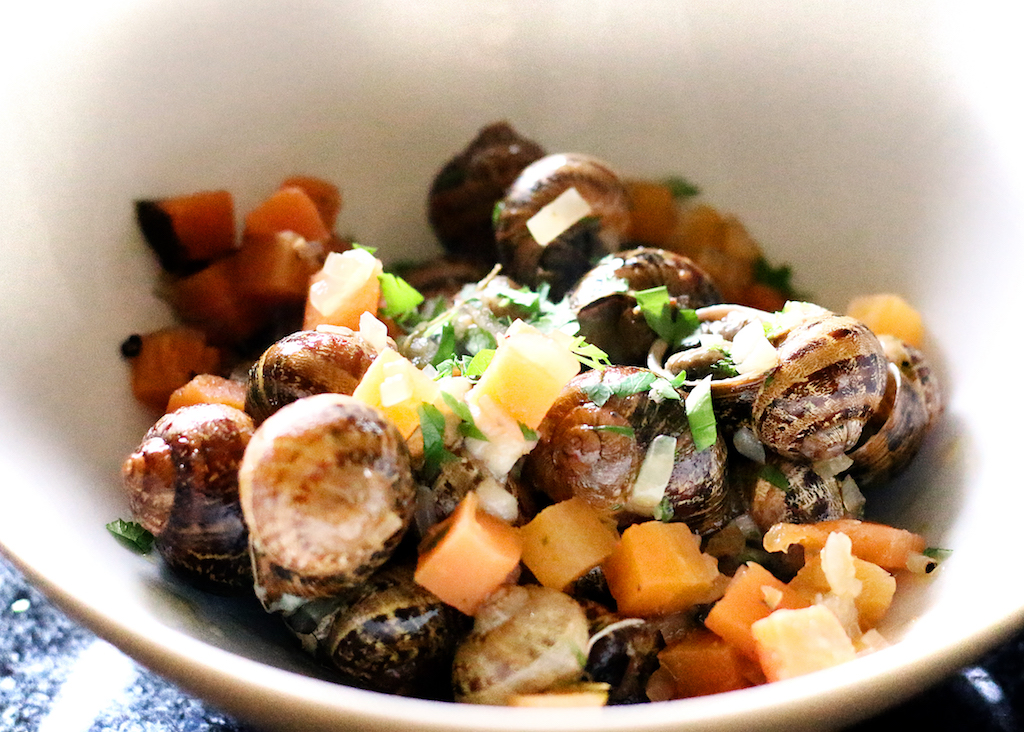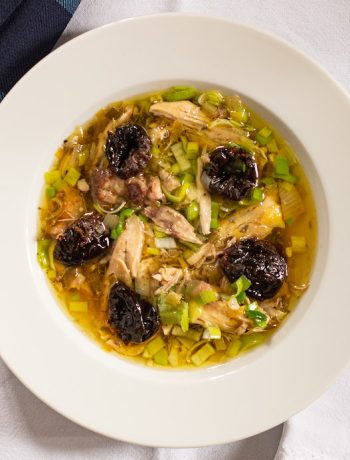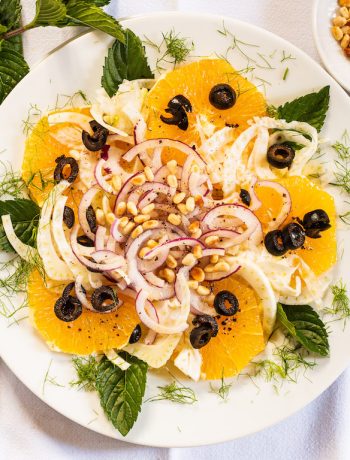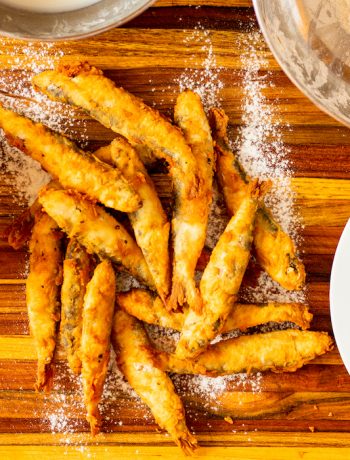Of all the eyebrow-raising recipes I do, this is the daddy. I would say that making food from English garden snails is a bit too much for about 90% of people I know. Only my friend Matthew has been brave enough to share a plate of these with me.
Let’s start with the basics. Why in the name of all that’s holy would a human being eat a snail? Larousse Gastronomique tells a tale that may surprise you. The results of archeological digs, where empty snail shells have been found gathered together, suggest that snails may have been one of first things that early humans ever ate. But get this, it takes until the Roman era before anyone cooked one. That means that humans were eating snails for 250,000 years … raw. While the Romans were cooking snails fattened and pissed up on grain and wine, the Gauls were having them for dessert. How peculiar.
In France, which is the country best known for snail eating, they have two varieties of snail. They have the Roman ‘Burgundy’ snail (Helix pomantia), which is a big old thing. Then they have a smaller garden snail, which they call petit gris. A read through a load of confusing and contradictory taxonomy reveals that petit gris is Helix aspersa aspersa, which is more correctly called Cornu aspersum. Cornu aspersum is the snail we have here in the UK, and it was imported, accidentally or otherwise from Europe and North Africa. The point of all this zoology is to convince you that if you pick up a British garden snail, you can be sure it is the same critter that the French eat as petit gris, and the French are not dying in their thousands from their starter. There is an absolutely lovely etymology for British snails where some people call them ‘Mendip wallfish.’ Little fish. Stuck on a wall. Isn’t that just great? The Mendips, incidentally, are a range of hills in Somerset, England, which is probably one of the first areas of the UK to end up with a decent snail population, given the migration route of snails from Gaul.
The last time I cooked snails, I posted my triumph on Facebook, and was met with a large number of comments suggesting that I was about to kill myself with a parasitic infection, or end up hospitalised from eating an unspecified, concentrated toxin. Yes, you can do all that (just like you can with eggs and chicken) if you don’t prepare the food properly, and here is how to do it. Gather your snails. For a decent starter, you are going to need twice as many Cornus as you would Roman snails, so reckon on 12 per person. Don’t bother with anything smaller than a 3cm shell. The best day to collect them on is a wet summer evening following a warm, dry day. You can also prop up a Frisbee with a stick and they will gather under that. Now, you need to get the toxins and the soil out of them. To do this, starve them on water alone for 3 days, and then feed them something nice and fresh. Whatever you feed them will alter the taste of the snail, so try basil, thyme and lettuce. I found that they don’t seem to like rocket so much – maybe they are not gentrified enough for rocket. Feed them on fresh water and leaves for another 4 days. Remember to clean their poo out through the cleansing week, or they will just be sitting around eating their own jobbies. Gordon Ramsay gives a tip to feed them on carrot, and prepare them for cooking once their Number Twos turn orange.
Once your week is up, you have a decision to make. Do you purge them of their slime or not? Many gastronauts proclaim that leaving it in there improves the taste of the snail. Others think that they can detect the slime in the cooked snail, and prefer it out. I have done snails both ways, and I opt for slime-in snails for four reasons: 1. The snails taste better; 2. Desliming snails is a lengthy, messy task; 3. It doesn’t actually work; 4. It’s downright cruel. The process involves putting salt and vinegar on the snails, and letting the poor things contort in agony for 48 hours, after which you wash them in a sieve with many, many changes of water. The snail cultivation industry has stopped doing this, and I will say no more on the matter.
Once you have your pathogen-free snails, you can cook them. This is achieved by shaking them (gently!) in a sieve to get them to retract into their shells. The Spanish sometimes use a method where snails (‘caracoles’) are cooked outside of their houses, but the French way is easier. Chill the snails in the fridge to make them go to sleep. Plunge the snails into boiling water for about 5 minutes. This kills them, but does not cook them. Drain them and then use something long and pointy to get them out of their shells. Cut off the black cloaca. the snails are then cooked for 2h in whatever concoction you might like, while the shells are washed and dried in a low oven. The classic snails recipe (given here for Cornus) is escargots à la bourguignonne, but there is a bit of a move to break away from the garlic butter and use them in salads, soups, and even deep fried.
The question is, are you brave enough for this?
Petit gris à la bourguignonne
Ingredients
- 50g butter, softened
- 3 garlic cloves, crushed
- 4 shallots, finely chopped
- Salt and pepper
- 24 garden snails, prepared and blanched (see above)
- 24 snail shells, washed 5 times and dried in a low oven (do not let the shells colour)
- 100ml dry white wine
- 100ml vegetable stock
- Half an onion, finely chopped
- 1 carrot, diced
- A bouquet garni (tied bunch of parsley stalks, bay leaf and thyme)
Instructions
Prepare a garlic butter by combining the butter, garlic and two of the shallots. Season and chill.
Simmer the white wine and stock in a frying or sauté pan, and add the remaining shallots, onion, carrot, bouquet garni and the snails. Season with salt, and simmer for 2 hours.
Leave the snails to cool in the pan
Heat an oven to 180˚C
Let the garlic butter come back up to room temperature and spoon a small amount into each shell. Put a snail in each shell and then seal the shells with more of the butter.
Arrange the snails in a snail tray if you have one (I just put three each in the wells of a muffin tin) and heat in the oven until bubbling (about 10 minutes).
Serve piping hot.
Notes
You can serve the snails with the braised vegetables for a heartier dish (see picture).








2 Comments
Matthew
12/08/2017 at 1:00 pmMy word, that must have been about 20 years ago but I remember it well! Worth the effort I think, if only to say you have tried them. Might not be trying this one with the girls but looking forward to more of your recipes…
Ali
28/09/2022 at 3:32 pmLove the ones you get in Normandy drenched in an almost luminous green herby, garlic sauce, with the morning pain to mop it up.
If you are near Caen try Le Crabe Vert in St. Aubin – is where we lived. Au revoir et bon appetite!